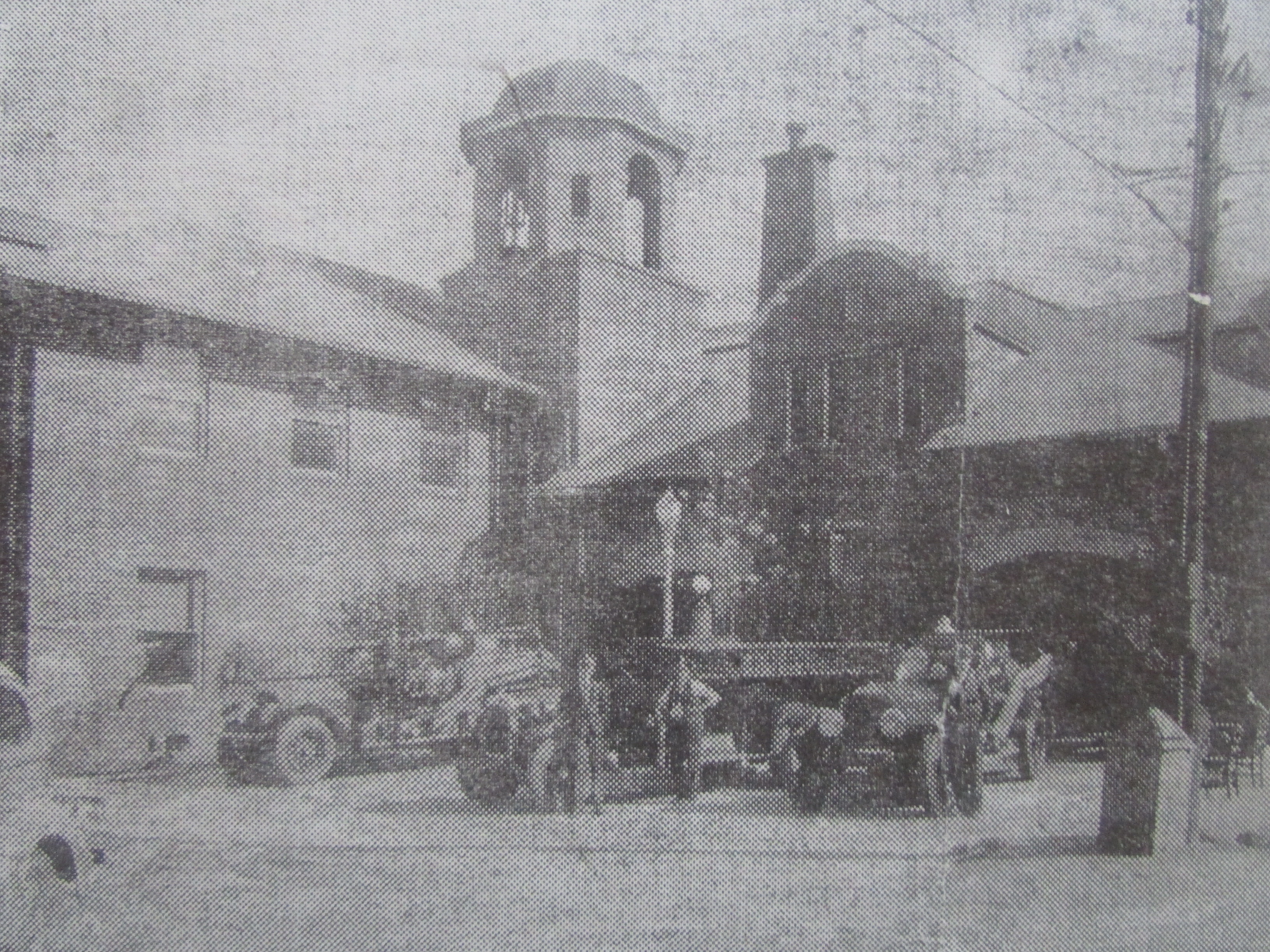It Started as a Home for Horses-Part 2
Published 3:42 pm Sunday, November 5, 2023

- More up to date vehicles were used to fight fires in the late 1960’s.
|
Getting your Trinity Audio player ready...
|
Last week we talked about the original incorporated fire companies, which were composed of daring and determined firemen that were also farmers, merchants, mechanics and clerks. We then went on to several devastating fires, which took an immense toll on Bainbridge. Today, we will discuss the early fire stations and go on to the construction of our ionic, historical, one of a kind, fire station, which is thankfully, still here, in our part of the south Georgia area, Now, it is known as the Firehouse Arts Center and Gallery.
Unfortunately, not much is known about the very early fire stations. However, we do know that the Stonewall Fire Engine Company No.1, had a fire house that was located on Clark Street. The Oak City Hook and Ladder Company had their livery stable on Broad Street. While Hurricane Michael causes much damage to that building, its memory is preserved and part of the remaining building is currently a public space and venue.
Back in the day, the men were equipped with all of the latest in fire fighting equipment available, most of which was made by the Hartshorn Company of New York. These machines consisted of a hand pump, which could throw two streams of water. It was pulled by two well trained horses. Also, there was a four-wheel hose carriage which carried 300 feet of hose and a two-wheel “jumper” carrying 600 feet of hose. These hose carriages were manned by twelve men. Eventually, there also was a large platform truck, when gasoline engines powered the vehicles of the day.
A longtime resident of Bainbridge shared these memories from these days of long ago. Try to picture what the inside of our fire station must have looked like when it was outfitted for horses. “The fire truck was really a fire wagon drawn by two stalwart, speedy and well trained horses, named Dan and Prince. They reminded folks of the team of horses that is featured in the beer advertising of today.
When the present county courthouse and fire station was built on West Water Street and the first brick pavement laid in the business district, the fire wagon was still horse drawn.”
He goes on to tell us: “The magnificent steeds were stalled on either side of the wagon tongue. The harness and other trappings was suspended from the ceiling above. When the alarm sounded, two chains dropped, enabling the two horses to quickly step into position on either side of the tongue. The harness was lowered to their bodies and it took only the buckling of a very few straps to make them ready for the run.
“A furious clanging of a huge gong that was manipulated by the foot of the driver, accompanied them all of the way to the fire. The principal alarm for the general public was a bell in a tower on the square and the steam whistle at the Light and Water Works on Clay Street.
“Every morning, at eleven o’clock, the alarms were tested and the horses given their daily exercise by running at a slower pace around the block bounded by Crawford, Broughton, Florida and Water Streets.”
He continues by sharing this story with us. “It was strictly against the rules, but a few of the boys delighted in hitching a ride on the back step, when the driver or another fireman was not watching.”
Also remembered by longtime residents is when once, the horse drawn fire wagon overturned at the corner of Calhoun and Independent Streets, while going to a fire. However, no one remembered if the horses were badly injured but it was a serious accident.
Some folks recalled that in the early days of Bainbridge, and well up in to the 20th century, every fire attracted a huge crowd of folks. Some were willing and anxious to help, while others just wanted to witness the excitement. This was so, until these gatherings were prohibited by a City Ordinance. However, it was also remembered that a gentleman named Clarke Guley, held the all time attendance record at these gatherings.
As you see, from these olden days up to now, fire departments and their equipment are interesting and always draw folks, when they can come and see these men and their equipment up close and in action.
In modern times, Bainbridge’s’ iconic fire house has charmed all who have enjoyed the beauty of its Mission style architecture, which was very popular in the early 20th century. Located on the corner of Crawford and Water Streets, this building was designed in 1914, by prominent Atlanta architect, William Augustus Edwards. Made from brick and stone, the architectural details of this building are enhanced by the parapet shaped walls, arched doorways, classical entrances and broad overhangs. Especially noticeable, are the two sets of large, double doors that face Water Street. They were large enough to accommodate the entering and exiting of even the fire trucks. During its time, this building not only was “home” to the fire house, but also served as City Hall, the Public Safety building as well as the library.
Bainbridge depended on this fire house not only to be the home of the fire department but to also ensure the protection of lives and property. It served this purpose from its opening day until the last fire truck pulled away, and the massive bay doors were closed and the building itself was shuttered for many years to come. However, being the last remaining building in this part of Georgia with the Mission style, citizens who appreciated older buildings, applied for historic status and it became an Historic Landmark in November of 1987.
After being used for many years, by 1991, the size of the city had increased so much that it had outgrown the building and had to relocate their offices to other places in downtown. The fire house now stood vacant for a few years, threatened with the rumor that the city planned to demolish it and build a parking lot! After all, every city becomes famous and attracts tourists to come and see their parking lots!
Thankfully, the residents of Bainbridge spoke up and a charge to save the building was led by a large number of interested citizens, who officially organized as the Decatur County Council for the Arts Inc. in June of 1992.
Then in 1993, a lease – purchase agreement was negotiated between the city of Bainbridge and the Arts Council. In 1995, the purchase of the building was finalized and the group of citizens interested in promoting the arts began the renovation process which would convert it into the Firehouse Arts Center and Gallery. Now, it was destined to become a multi – use cultural center for exhibits, concerts, meetings, lectures and other forms of entertainment.
In 2001, the restoration began, Slowly, stages for improvements were studied with each step taking its time. Considering its age and the numerous changes that had been made in the past to the structure, it was found to be in good condition. Thankfully, many of the original details of the architecture that had been previously covered up by past renovations, were able to be uncovered and revealed. Everyone was overjoyed that many of these modifications, did not change the original building. Nor were any parts of the original structure taken out, but had been built around. Even the smallest of details, like the type of bricks used, made it possible to see where a new section was added to the original building.
However, there were problems discovered, like a large, exterior crack which suggested a wooden arch support was inadequate. Also, rotting wood near the plumbing, which told of leaking pipes sometime during the buildings past.
A well-rounded hole, which had been chiseled through layers of brick and mortar, exposed where a ventilation pipe had once been. A suspension ceiling, that had been added several decades before, suggested a problem with the original ceiling, which was above the suspended one. The peeling paint on the original ceiling proved that there had to have been occasional leaks.
The second floor, which had not been used in 25 years because of deterioration, presented the greatest possibilities. Therefore, extensive renovations were planned there. They included the installation of an elevator next to a grand staircase, where natural light entered from the renovated, Plexiglas enclosed, bell tower.
Can you imagine the awe and joy of when the original ceiling beams and brickwork were uncovered and now revealed a large, beautiful room, with a 17-foot high ceiling! It must have been like finding a hidden treasure chest! This area then became the Callahan Room, which is now used for dinner receptions and public meetings.
This is when more uses for the upper floor fired the imaginations of those who were planning the uses for this space. It was envisioned that another section of this space would become a rehearsal hall for the Bainbridge British Brass Band.
While all of this was going on to the second floor level, at the same time, the bottom floor, where the Public Safety part of the building used to be, now became where the Decatur County Historical Society Museum was located.
Many local folks contributed to the success of the renovations, some with money and some with their time. Because of the devotion of Joyce Leverett and Phyllis Lucas, in 2009, a Memorial Courtyard Garden was created. A plaque attached on the exterior wall lists the names of the people who donated and supported the garden area. Attracting the most attention is the Memorial Brick patio floor. Each individual who purchased a brick was entitled to have their name, or the name of a loved one, etched on the brick. Folks love to gather and read and remember those that are mentioned.
Also, thanks to funds received from the Edward C. Fogg III and Lisbeth A. Fogg Charitable Trust in 2018, it was possible to replace the cracked, uneven concrete flooring of the main floor of the building, update the kitchen with new cabinets and appliances, paint the building inside and out, develop the new Kirbo Gallery Center and purchase four new art display walls.
As with many historic buildings, a bit of mystery surrounds it. The basement once contained the police department and jail. Volunteers found it very interesting to go through the boxes of old radar equipment, police files and fingerprint sheets, that were left behind by the police when they moved to their new location. It was easy to separate the historic graffiti in the jail cells, which was made by earlier residents, from those made by recent intruders. This was because prisoners rarely had pens, so they made their marks with lighter burns. What appears to have been a bricked-over doorway, was found about 20 feet underground. It is said by some to have been where there was a door that led to an underground passageway that then led from the jail to the courthouse across the street. By using this tunnel, it would have been possible to take inmates from the jail to the courtroom for their trial with complete security.
Thanks to the efforts of many public-spirited citizens and art lovers, this wonderful one of a kind building stands today in the Historic District, just off the center of town, Here, folks can gather for art exhibits, entertainment and celebrations. It is now one of the most beautiful and most photographed buildings in downtown Bainbridge.





